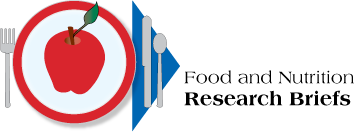| January 2014 |
Healthy Breakfast: A "Plus" for Kids' Math Performance, Study Shows Eating breakfast—or choosing to skip it—may significantly influence a child's ability to solve math problems, according to the results of a nutrition study funded by the Agricultural Research Service (ARS). Work with 81 healthy children has indicated that those who ate breakfast were better able to tackle dozens of math problems in rapid-fire succession than peers who didn't have a morning meal. EEG data showed that youngsters who had skipped breakfast had to exert more effort to perform the "mental math" that the tests required, and to stay focused on the task at hand. In contrast, those who had eaten breakfast used less mental effort to solve the problems, stayed more focused on the tests, and improved their scores in the post-breakfast test. The study is apparently the first published investigation, with 8- to 11-year-olds, that controlled the time and content of the morning meal and used EEG technology to monitor brain activity while the children were solving math problems. For details, contact: R. Terry Pivik, (501) 364-3346, ARS Arkansas Children's Nutrition Center, Little Rock, Ark. |
|
Back to Contents Researchers Investigate Nut Allergy Mechanisms Agricultural Research Service (ARS) scientists teamed with university collaborators to validate the ability of a database of allergenic proteins to predict when a person who is allergic to one kind of nut may also be allergic to proteins in another kind of nut, a condition called "cross-reactivity." Proteins between cross-reactive nuts are thought to have similar IgE antibody-recognition sites. The researchers took known IgE binding sites (epitope sequences) from peanut and nut proteins and ran those through the Structural Database of Allergenic Proteins (SDAP) database in order to predict cross-reactive epitopes in other nuts. The finding indicates that the SDAP database can be useful for predicting previously unidentified cross-reactive epitopes, based on their similarity to known IgE epitopes. For details, contact: Soheila J. Maleki, (504) 286-4590, ARS Food Processing and Sensory Quality Research Unit, New Orleans, La. Back to Contents Tiny Doses of Bile Acid May Blunt Preemie Liver Disease Giving premature babies small doses of a bile acid might help the newborns avoid a liver disease, according to Agricultural Research Service (ARS) studies. In a preliminary study with newborn piglets as the animal model, bile acid CDCA (chenodeoxycholic acid) helped combat parenteral nutrition-associated liver disease (PNALD), a liver condition that sometimes occurs in preemies nourished exclusively through intravenous feeding. Known as total parenteral nutrition, this feeding regimen can save lives, but if administered for longer than two weeks, may lead to complications such as PNALD. There is no well-established, science-based cure for PNALD. In severe cases, PNALD can lead to liver failure and the need for a liver transplant. For details, contact: Douglas G. Burrin, (713) 798-7049, ARS Children's Nutrition Research Center, Houston, Texas. Back to Contents Project Aims to Biofortify Rice for Improved Nutritional Value A team of Agricultural Research Service (ARS) scientists and their collaborators is closing in on genes in rice that regulate the uptake and storage of important minerals, a pursuit that could bolster the nutritional value of this cereal grain crop as a staple food of roughly half the world's population. The ultimate goal is to conventionally breed new rice varieties whose grains boast exceptionally high concentrations of one or more of 14 essential minerals, including zinc, iron and calcium. In developing countries, re-fortifying rice after milling may not be a viable option. For details, contact: Shannon Pinson, (870) 672-9300, ARS Dale Bumpers National Rice Research Center, Stuttgart, Ark. Back to Contents Farmed Salmon Raises Blood Levels of Omega-3s People who eat farm-raised salmon can increase their intake of beneficial omega-3 fatty acids to levels that may help reduce their risk of heart disease, according to studies by Agricultural Research Service (ARS) scientists. The studies specifically addressed concerns about whether farm-raised salmon have less available omega-3s than salmon caught in the wild. Two omega-3 fatty acids—EPA (eicosapentaenoic acid) and DHA (docosahexaenoic acid)—were examined. EPA blood levels doubled after the volunteers consumed the 6.3-ounce portions, and increased nearly threefold after they consumed the 9.5-ounce portions. Also, based on the blood indicators, DHA levels were elevated by about 50 percent, regardless of portion size. For details, contact: Susan Raatz, (701) 795-8294, ARS Grand Forks Human Nutrition Research Center, Grand Forks, N.D. Back to Contents Plant Compounds Studied for Food Safety Chores Agricultural Research Service (ARS) scientists and their university collaborators are taking a fresh look at the ability of olive powder and other plant compounds to combat foodborne pathogens. Some of the studies focus on control of microbes such as Escherichia coli O157:H7 and also looked at control of two possibly carcinogenic heterocyclic amines, MelQx and PhIP, that can be formed during cooking of meats. High levels of E. coli O157:H7 were added to ground beef patties along with either olive powder or other plant compounds. The patties were cooked to the recommended temperature of 160 degrees F and then were tested for levels of E. coli and the two amines. When the E. coli and amine results were evaluated as a whole, olive powder was shown to outperform the other powders (apple, onion, or garlic, for instance) that were tested. For details, contact: Mendel Friedman, (510) 559-5615, ARS Produce Safety and Microbiology Research Unit, Albany, Calif. Back to Contents French Fries' Oil Content: It's Lower with Infrared Heat Prepping raw french fries for three minutes with infrared (IR) heat before the fries are dunked in the deep fat fryer can reduce oil uptake by about one-third, as compared to raw fries not treated with IR, according to Agricultural Research Service (ARS) studies. Of 77 volunteer taste-testers who sampled the fries, more than half said they found the taste and color of the IR-prepped fries to be no different from that of conventionally prepared fries. More than half of the panelists said they preferred the IR fries' crunchier texture. The idea of prepping fries to help reduce oil uptake isn't new. But these experiments are apparently the first to extensively explore IR as a prepping option for fresh or partially processed french fries. For details, contact: Zhongli Pan, (510) 559-5861, ARS Processed Foods Research Unit, Albany, Calif. Back to Contents Broader Scope May Enhance UV Screening of Navel Oranges Packinghouse workers know to promptly cull any oranges that have a distinctive "fluorescence signature" on the peel under ultraviolet (UV) light. That's because more likely than not, the spots are telltale indicators of the presence of Penicillium microbes that cause blue mold or green mold. But other, less-studied patterns of fluorescence on navel orange peels may warrant more attention. Fluorescence in the form of specks, smears, smudges or blotches, for instance, may indicate the presence of cuts, punctures or other peel wounds that may pave the way to attack by decay microbes. To learn more about these less familiar patterns, ARS researchers sampled about 5,000 navel oranges over a two-year period. Oranges were sorted by fluorescence level—zero, sparse, moderate or high—as noted during UV screening. In addition, the oranges were evaluated under normal light—not UV—within 24 hours after UV screening and after the fruit had been stored at 59 degrees F for three weeks. As expected, fruit with high fluorescence developed further decay and peel-quality problems during storage, but so did many of the oranges that had only moderate fluorescence. For details, contact: David M. Obenland, (559) 596-2801, ARS Commodity Protection and Quality Research Unit , Parlier, Calif. Back to Contents ARS Scientists Develop Improved Method to Estimate Calories Agricultural Research Service (ARS) scientists have improved the method for estimating calories in tree nuts, showing that there are fewer calories in pistachios and almonds than previously thought. The modified method should also work well for other foods. The researchers fed 16 healthy adults pistachios at three different levels: none, 1.5 ounces per day, and 3 ounces per day, along with a background, or "base," nut-free diet. The volunteers ate each pistachio level for 18 days. Researchers collected and analyzed urine and stool samples from all feeding periods. The study suggests that the caloric value of pistachios has likely been overestimated by about 5 percent, because the fat from the nuts wasn't completely absorbed by the intestinal tract. For details, contact: David Baer, (301) 504-8719, ARS Food Components and Health Laboratory, Beltsville, Md. Back to Contents Ramping Up Pterostilbene in Crops A team of Agricultural Research Service (ARS) scientists has developed a way to boost production of a beneficial plant compound called pterostilbene in crops like blueberries that already produce it and also add it to crops that don't commonly produce it, such as grapes. There are two stilbenes—resveratrol and pterostilbene—that may possess similar purported beneficial health properties. The team showed that a previously characterized and patented gene called SbOMT3, which they had isolated from the sorghum plant, is capable of converting resveratrol to pterostilbene. They then built on that conversion activity by co-expressing SbOMT3 with a stilbene-synthase gene, AhSTS3, that had been isolated from the peanut plant. The two-gene strategy generated transgenic plants that were able to produce pterostilbene. For details, contact: Scott Baerson, (662) 915-7965, ARS Natural Products Utilization Research Unit, Oxford, Miss. Back to Contents The Search for What Makes a Tasty Tomato Agricultural Research Service (ARS) researchers at Geneva, N.Y., have worked with a North Carolina State University scientist to explore tomato's genetic diversity in a study designed to help breeders develop tastier tomatoes. The team raised 173 varieties on test plots in North Carolina, trained 10 volunteers in sensory analysis, and asked them to rate the varieties on a scale of one to five in four sensory areas: odor, taste, flavor, and texture. The varieties were selected from the approximately 6,000 accessions in the ARS Tomato Germplasm Collection. The results, published in Plant Genetic Resources: Characterization and Utilization (2013), represent one of the most comprehensive efforts to date for identifying sources for boosting flavor among commercial varieties and lines used for breeding. For details, contact: Joanne Labate, (315) 787-2438, ARS Plant Genetic Resources Unit, Geneva, N.Y. 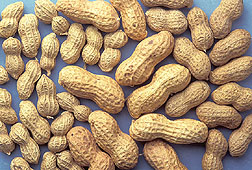
Researchers took known IgE binding sites (epitope sequences) from peanut proteins and ran those through the SDAP database in order to predict cross-reactive epitopes in other nuts. 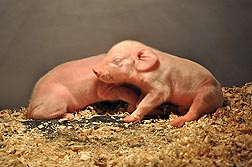
Using newborn piglets as a model for premature human babies, preliminary ARS studies have found that small doses of a bile acid might help the newborns avoid a serious liver disease.
Shannon Pinson and AgriLife plant physiologist Lee Tarpley (foreground), and technicians examine diverse rice lines found to have high concentrations of specific minerals in their grain.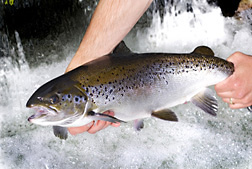
Eating farm-raised salmon can increase people's intake of beneficial omega-3 fatty acids to levels that may help reduce their risk of heart disease. 
New research has shown the roles that a powder made from olives can play in helping keep hamburgers safe to eat.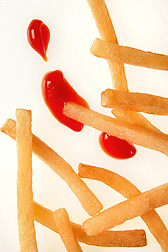
Fries prepped with infrared heat before frying have less fat than conventionally prepared fries. 
Patterns of blotches that fluoresce when navel oranges are inspected with ultraviolet light at packinghouses might indicate damage and increased risk of decay. 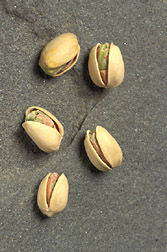
An improved method for estimating calories in nuts has shown that pistachios and almonds have fewer calories than previously thought. 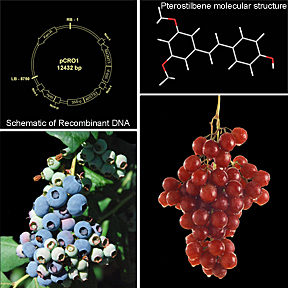
ARS scientists have developed a two-gene strategy that can boost production of the beneficial phytochemical pterostilbene in crops like blueberries that already produce it and also add it to crops that don't commonly produce it, such as grapes.
One of numerous varieties of tomatoes grown and analyzed for compounds that play a role in determining flavor.

